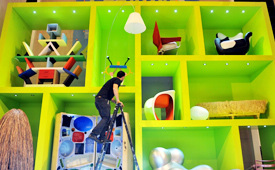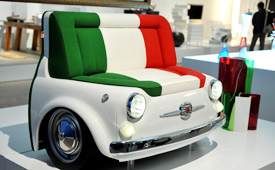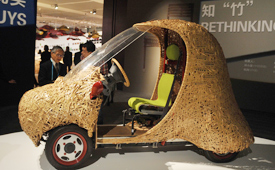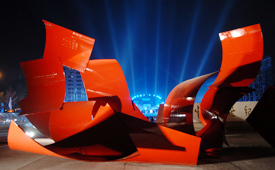|
 |
 |
|
VERTICAL HOME: In the colorful installation by Italian designer Andrea Branzi, Vertical Home, 28 works of industrial design are arranged on two shelves, as an interpretation of space in China's traditional shelves. Pictured is one shelf of the work (CFP) |
TOY-LIKE SOFA: Panorama, a sofa from the Fiat 500 Design Collection by Lapo Elkann, an Italian industrialist and creative entrepreneur (CFP) |
 |
 |
|
A NATURAL CAR: Bamgoo, a concept electric car with its body made of bamboo strips, was developed by Kyoto University Venture Business Laboratory (CFP) |
SCROLLS WITH POEMS: Manuscript, a major installation designed by Paul Cocksedge, celebrates the convergence of literature, industry and culture (BAI SHI) |
Apart from the range of items on show, the designers themselves are a key part of the events' attraction. Lovers of design will have a chance to interact with more than 300 design celebrities.
Many of those who were present stand at the pinnacle of the contemporary design world including acclaimed British designer and architect Zaha Hadid; Japan's Naoto Fukasawa, designer for dozens of major brands; and renowned French minimalist Philippe Starck. Chinese designers from the mainland, Hong Kong, Taiwan and Macao accounted for 30 percent of the total.
While the triennial is in itself a feast of design, more than 130 additional activities involving Chinese and international designers will take place during the event.
Many of the exhibitions and events were sponsored by the event's international partners. Meet Design, an ongoing Italian initiative highlighting the country's design prowess, was in town for the occasion, while the Netherlands launched the Dutch Design Generator pavilion to express the vitality of its industry. Austria stole the show, however, representing its place in world design with an enormous chair-shaped cake.
While the individual works of art on display are stunning and inspire awe and genuine contemplation, the event is also making a tangible contribution to the design and architectural environment of its host city.
Dashilar, a rundown historic quarter in the heart of Beijing, near Tiananmen Square, was the venue for several events.
With sponsorship from global brands including TopShop, unoccupied space in the neighborhood was given over to local artists and designers, heralding the rebirth of the neighborhood as a center of design.
"This place is a very important and historic neighborhood," said Aric Chen. "For centuries Dashilar was the commercial, social and cultural center of the city, and visible traces of this status make it unique in the capital today. However, over the last few decades the conditions in Dashilar have declined considerably. The event has given the historic area an opportunity to renew itself during the design week."
Dashilar Alley featured more than 20 exhibitions and events from around the world. Along the historic commercial street of Dashilar Xijie, empty storefronts were taken over by artists' installations and temporary cafes, and pop-up shops from leading brands and boutiques appeared on the street.
"The idea is to bring a renewed public awareness of Dashilar, in the hope of transforming the area in a more sensitive and organic way," Chen said.
In addition to Dashilar, events and exhibitions were also held at other Beijing landmarks, such as 751D-Park in the 798 Art Zone, Sanlitun Village, and Tsinghua University. In total more than 60 famous brands and about 800 international designers were involved.
With such a vast concentration of international design resources temporarily gathered in the city, Beijing now has at its disposal expertise that will help it move to the forefront of the world's design stage. |
